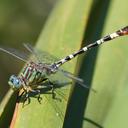United States and Canada
Fairly common to uncommon species of the southwest. Brightly marked like many ringtail species. Frequently encountered perched on vegetation or on rocks near riffles along flowing streams.
In the field, males appear prominently clubbed, females less so; eyes blue; complex thorax pattern; bright white rings S2-7 and amber, orange or yellow highlights on clubbed S8-10.
Eyes blue, face white, frons black. Thorax pattern complex pattern of greenish-blue or greenish-yellow stripes against a black or brown background. Abdomen black, prominently ringed with white on segments 2-7. Segments 8-10 prominently highlighted with orange, yellow or amber, variably blackish on dorsal surface.
Wings may be variably amber or reddish at base.
Geographic Variation: Two distinct populations are distinct enough to be separable in the field. The population in coastal southern California south into adjacent Baja California (Erpetogomphus l. lampropeltis) has a pale grayish/green or grayish/blue and dark brown pattern on the thorax; mostly dark legs; and a less strongly patterned abdomen. The subspecies or group (?) (Erpetogomphus l. natrix) found in Arizona (and cape district of baja?) south have a bright green and dark brown or black thorax; and more boldly patterned abdomen.
Size and structure: Total length: 41-56 mm; abdomen: hindwing: 27-35 mm.In field appears medium/large. Appears about the same size but more slender and articulated than Flame Skimmer. Clearly larger than Blue Dasher; clearly smaller than Common Green Darner.
Male's abdomen tapered over S1-2; moderately slender from S3-S6 and swollen club tip from S7-S10. The female's abdomen is more tubular in shape, but still with a hint of a club.
Similar Species: California group (E. l. lampropeltis) is distinguished easily from White-belted Ringtail (Erpetogomphus compositus), which is the only ringtail that occurs in its range, by the White-belted's far brighter patterning, including bright black, yellow and white stripes on the thorax.
The Arizona group (E. l. natrix) is the only ringtail in its range with a bluish-green and brown/black striped thorax.
Habitat: Clear streams, drainage ditches, canals and rivers of with moderate current, generally in arid areas.
Natural History: Typically perches horizontally on twigs and rocks near riffles in streams from water level up to waist height. Also perches away from water and up to tree height above streams.
Females fly swiftly, occasionally hovering over the water, tapping their abdomens on the surface at intervals of several feet.
Distribution: Erpetogomphus l. lampropeltis Coastal Southern California south to adjacent Baja California. Erpetogomphus l. natrix group a disjunct population in Arizona and New Mexico sound in the Sierra Madre Occidental to Durango and possibly as far as Guatemala.
Source: Based on account of Eastern Ringtail from Abbott, J.C. 2006-2010. OdonataCentral: An online resource for the distribution and identification of Odonata. Available at OdonataCentral.
Edited by David Bell (9/24/2015).
